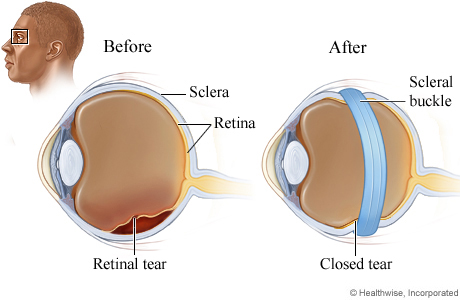Health Library
We have a vast digital library of medical information, including wellness and psychiatry topics as well as general medical topics. For more information or to schedule an appointment, don’t hesitate to call us.
Our Health Library information does not replace the advice of a doctor. Please be advised that this information is made available to assist our patients to learn more about their health. Our providers may not see and/or treat all topics found herein. Scleral buckling surgery is a common way to treat retinal detachment. It is a method of closing breaks and flattening the retina. A scleral buckle is a piece of silicone sponge, rubber, or semi-hard plastic that your eye doctor (ophthalmologist) places on the outside of the eye (the sclera, or the white of the eye). The material is sewn to the eye to keep it in place. The buckling element is usually left in place permanently. The element pushes in, or "buckles," the sclera toward the middle of the eye. This buckling effect on the sclera relieves the pull (traction) on the retina, allowing the retinal tear to settle against the wall of the eye. The buckle effect may cover only the area behind the detachment, or it may encircle the eyeball like a ring. By itself, the buckle does not prevent a retinal break from opening again. Usually extreme cold (cryopexy) or, less commonly, heat (diathermy) or light (laser photocoagulation) is used to scar the retina and hold it in place until a seal forms between the retina and the layer beneath it. The seal holds the layers of the eye together and keeps fluid from getting between them. A scleral buckle is a piece of silicone sponge, rubber, or semi-hard plastic. In scleral buckling surgery, the buckle is placed against the outer surface of the eye and sewn onto the eye to keep it in place. The buckle pushes the sclera toward the middle of the eye, relieving the pull on the retina and allowing the tear to settle against the wall of the eye. Extreme cold (cryopexy) or light (laser photocoagulation) is used to scar the area around the tear. The scarring helps keep this area from moving so that a seal can form between the retina and the layer beneath it. In most cases, the buckle will stay on the eye forever. You may have some pain in your eye and your vision may be blurry for a few days after the surgery. Your eye may be swollen, red, or tender for several weeks. Your eye doctor may put drops in your eye that prevent infection and keep the pupil from opening wide (dilating) or closing (constricting). You may have to wear a patch over the eye for a day or more. Scleral buckling is effective in supporting a tear, hole, or break in the retina that has caused the detachment. It is rarely helpful on its own when scar tissue tugging on the retina has caused the detachment (traction detachment). Placing a scleral buckle reattaches the retina in most cases.footnote 1 Chances for good vision after surgery are higher if the macula was still attached before surgery. If the detachment affected the macula, good vision after surgery is still possible but less likely. Scleral buckling poses some short-term and long-term risks. Most of these complications do not happen very often. Risks include the following: The surgery may also affect your vision in other ways: Current as of: July 31, 2024 Author: Ignite Healthwise, LLC Staff Current as of: July 31, 2024 Author: Ignite Healthwise, LLC Staff Clinical Review Board This information does not replace the advice of a doctor. Ignite Healthwise, LLC disclaims any warranty or liability for your use of this information. Your use of this information means that you agree to the Terms of Use and Privacy Policy. Learn how we develop our content. To learn more about Ignite Healthwise, LLC, visit webmdignite.com. © 2024-2025 Ignite Healthwise, LLC.Scleral Buckling Surgery for Retinal Detachment
Surgery Overview
Other facts about the surgery
How It Is Done

What To Expect
Why It Is Done
How Well It Works
Risks
Credits
Clinical Review Board
All Ignite Healthwise, LLC education is reviewed by a team that includes physicians, nurses, advanced practitioners, registered dieticians, and other healthcare professionals.
All Ignite Healthwise, LLC education is reviewed by a team that includes physicians, nurses, advanced practitioners, registered dieticians, and other healthcare professionals.



